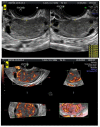Performance of IOTA Simple Rules Risks, ADNEX Model, Subjective Assessment Compared to CA125 and HE4 with ROMA Algorithm in Discriminating between Benign, Borderline and Stage I Malignant Adnexal Lesions
- PMID: 36900029
- PMCID: PMC10000903
- DOI: 10.3390/diagnostics13050885
Performance of IOTA Simple Rules Risks, ADNEX Model, Subjective Assessment Compared to CA125 and HE4 with ROMA Algorithm in Discriminating between Benign, Borderline and Stage I Malignant Adnexal Lesions
Abstract
Background: Borderline ovarian tumors (BOTs) and early clinical stage malignant adnexal masses can make sonographic diagnosis challenging, while the clinical utility of tumor markers, e.g., CA125 and HE4, or the ROMA algorithm, remains controversial in such cases.
Objective: To compare the IOTA group Simple Rules Risk (SRR), the ADNEX model and the subjective assessment (SA) with serum CA125, HE4 and the ROMA algorithm in the preoperative discrimination between benign tumors, BOTs and stage I malignant ovarian lesions (MOLs).
Methods: A multicenter retrospective study was conducted with lesions classified prospectively using subjective assessment and tumor markers with the ROMA. The SRR assessment and ADNEX risk estimation were applied retrospectively. The sensitivity, specificity, positive and negative likelihood ratios (LR+ and LR-) were calculated for all tests.
Results: In total, 108 patients (the median age: 48 yrs, 44 postmenopausal) with 62 (79.6%) benign masses, 26 (24.1%) BOTs and 20 (18.5%) stage I MOLs were included. When comparing benign masses with combined BOTs and stage I MOLs, SA correctly identified 76% of benign masses, 69% of BOTs and 80% of stage I MOLs. Significant differences were found for the presence and size of the largest solid component (p = 0.0006), the number of papillary projections (p = 0.01), papillation contour (p = 0.008) and IOTA color score (p = 0.0009). The SRR and ADNEX models were characterized by the highest sensitivity (80% and 70%, respectively), whereas the highest specificity was found for SA (94%). The corresponding likelihood ratios were as follows: LR+ = 3.59 and LR- = 0.43 for the ADNEX; LR+ = 6.40 and LR- = 0.63 for SA and LR+ = 1.85 with LR- = 0.35 for the SRR. The sensitivity and specificity of the ROMA test were 50% and 85%, respectively, with LR+ = 3.44 and LR- = 0.58. Of all the tests, the ADNEX model had the highest diagnostic accuracy of 76%.
Conclusions: This study demonstrates the limited value of diagnostics based on CA125 and HE4 serum tumor markers and the ROMA algorithm as independent modalities for the detection of BOTs and early stage adnexal malignant tumors in women. SA and IOTA methods based on ultrasound examination may present superior value over tumor marker assessment.
Keywords: ADNEX model; CA125; HE4; International Ovarian Tumor Analysis (IOTA); Simple Rules Risk; borderline ovarian tumors; complex adnexal mass; ovarian cancer; risk of malignancy algorithm (ROMA).
Conflict of interest statement
The authors declare no conflict of interest.
Figures





References
LinkOut - more resources
Full Text Sources
Research Materials
Miscellaneous

